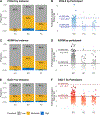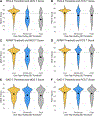Mood instability metrics to stratify individuals and measure outcomes in bipolar disorder
- PMID: 39526287
- PMCID: PMC11545575
- DOI: 10.1038/s44220-024-00291-5
Mood instability metrics to stratify individuals and measure outcomes in bipolar disorder
Abstract
Clinical care for bipolar disorder (BD) has a narrow focus on prevention and remission of episodes with pre/post treatment reductions in symptom severity as the 'gold standard' for outcomes in clinical trials and measurement-based care strategies. The study aim was to provide a innovative method for measuring outcomes in BD that has clinical utility and can stratify individuals with BD based on mood instability. Participants were 603 with a BD (n=385), other or non-affective disorder (n=71), or no psychiatric history (n=147) enrolled in an longitudinal cohort for at least 10 years that collects patient reported outcomes measures (PROMs) assessing depression, (hypo)mania, anxiety, and functioning every two months. Mood instability was calculated as the intraindividual standard deviation (s.d.) of PROMs over one-year rolling windows and stratified into low, moderate, and high thresholds, respectively. Individuals with BD had significantly higher one-year rolling SDs for depression, (hypo)mania, and anxiety compared to psychiatric comparisons (small - moderate effects) and healthy controls (large effects). A significantly greater proportion of scores for those with BD fell into the moderate (depression: 50.6%; anxiety: 36.5%; (hypo)mania: 52.1%) and high thresholds (depression: 9.4%; anxiety: 6·1%; (hypo)mania: 10·1%) compared to psychiatric comparisons (moderate: 32.3 - 42·9%; high: 2.6% - 6·6%) and healthy controls (moderate: 11.5% - 31.7%; high: 0.4% - 5.8%). Being in the high or moderate threshold predicted worse mental health functioning (small to large effects). Mood instability, as measured in commonly used PROMs, characterized the course of illness over time, correlated with functional outcomes, and significantly differentiated those with BD from healthy controls and psychiatric comparisons. Results suggest a paradigm shift in monitoring outcomes in BD, by measuring intraindividual SDs as a primary outcome index.
Conflict of interest statement
Competing Interests Statement Melvin G. McInnis has received consulted and research support from Janssen Pharmaceuticals and has two US patents to the University of Michigan (US Patent #9,685,174; US Patent #11, 545, 173). AKY and SHS have no disclosures to report.
Figures



Update of
-
Beyond traditional metrics: A novel method for measuring mood instability in bipolar disorder.Res Sq [Preprint]. 2024 Jan 24:rs.3.rs-3880090. doi: 10.21203/rs.3.rs-3880090/v1. Res Sq. 2024. Update in: Nat Ment Health. 2024 Sep;2(9):1111-1119. doi: 10.1038/s44220-024-00291-5. PMID: 38343860 Free PMC article. Updated. Preprint.
Similar articles
-
Beyond traditional metrics: A novel method for measuring mood instability in bipolar disorder.Res Sq [Preprint]. 2024 Jan 24:rs.3.rs-3880090. doi: 10.21203/rs.3.rs-3880090/v1. Res Sq. 2024. Update in: Nat Ment Health. 2024 Sep;2(9):1111-1119. doi: 10.1038/s44220-024-00291-5. PMID: 38343860 Free PMC article. Updated. Preprint.
-
Mood instability as a predictor of clinical and functional outcomes in adolescents with bipolar I and bipolar II disorder.J Affect Disord. 2018 Aug 15;236:199-206. doi: 10.1016/j.jad.2018.04.021. Epub 2018 Apr 9. J Affect Disord. 2018. PMID: 29747137 Free PMC article.
-
Ecological Momentary Assessment of Bipolar Disorder Symptoms and Partner Affect: Longitudinal Pilot Study.JMIR Form Res. 2021 Sep 2;5(9):e30472. doi: 10.2196/30472. JMIR Form Res. 2021. PMID: 34473069 Free PMC article.
-
Cognitive deficits in bipolar disorders: Implications for emotion.Clin Psychol Rev. 2018 Feb;59:126-136. doi: 10.1016/j.cpr.2017.11.006. Epub 2017 Nov 21. Clin Psychol Rev. 2018. PMID: 29195773 Free PMC article. Review.
-
[Early intervention in bipolar affective disorders: Why, when and how].Encephale. 2022 Feb;48(1):60-69. doi: 10.1016/j.encep.2021.05.007. Epub 2021 Sep 23. Encephale. 2022. PMID: 34565543 Review. French.
References
-
- He H, Hu C, Ren Z, Bai L, Gao F, Lyu J. Trends in the incidence and DALYs of bipolar disorder at global, regional, and national levels: Results from the global burden of Disease Study 2017. Journal of psychiatric research. 2020;125:96–105. - PubMed
-
- Yocum AK, Friedman E, Bertram HS, Han P, McInnis MG. Comparative mortality risks in two independent bipolar cohorts. Psychiatry Res. 2023;330:115601. - PubMed
-
- Bauer M, Andreassen OA, Geddes JR, Kessing LV, Lewitzka U, Schulze TG, et al. Areas of uncertainties and unmet needs in bipolar disorders: clinical and research perspectives. The Lancet Psychiatry. 2018;5(11):930–9. - PubMed
-
- Henry C, Mitropoulou V, New AS, Koenigsberg HW, Silverman J, Siever LJ. Affective instability and impulsivity in borderline personality and bipolar II disorders: similarities and differences. Journal of psychiatric research. 2001;35(6):307–12. - PubMed
-
- Bauer M, Glenn T, Grof P, Schmid R, Pfennig A, Whybrow PC. Subsyndromal mood symptoms: a useful concept for maintenance studies of bipolar disorder? Psychopathology. 2009;43(1):1–7. - PubMed
Grants and funding
LinkOut - more resources
Full Text Sources
